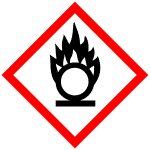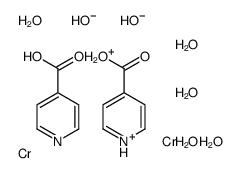104316-83-8
| 中文名 | 4-羧氧基吡啶重铬酸盐 |
|---|---|
| 英文名 | oxido-(oxido(dioxo)chromio)oxy-dioxochromium,pyridin-1-ium-4-carboxylic acid |
| 英文别名 |
4-Carboxypyridinium dichromate
MFCD00074862 |
| 分子式 | C12H24Cr2N2O11 |
|---|---|
| 分子量 | 476.31800 |
| 精确质量 | 476.01900 |
| PSA | 182.90000 |
| LogP | 0.60160 |
| 储存条件 | 保持贮藏器密封、储存在阴凉、干燥的地方,确保工作间有良好的通风或排气装置 |
| 稳定性 | 如果遵照规格使用和储存则不会分解,未有已知危险反应,避免强氧化物、酒精 |
| 更多 | 1. 性状:未确定 2. 密度(g/mL,20ºC):未确定 3. 相对蒸汽密度(g/mL,空气=1):未确定 4. 熔点(ºC):未确定 5. 沸点(ºC):未确定 6. 沸点(ºC,5mmHg):未确定 7. 折射率:未确定 8. 闪点(°F):未确定 9. 比旋光度(ºF):未确定 10. 自燃点或引燃温度(ºC):未确定 11. 蒸气压(kPa,20ºC):未确定 12. 饱和蒸气压(kPa,110ºC):未确定 13. 燃烧热(KJ/mol):未确定 14. 临界温度(ºC):未确定 15. 临界压力(KPa):未确定 16. 油水(辛醇/水)分配系数的对数值:未确定 17. 爆炸上限(%,V/V):未确定 18. 爆炸下限(%,V/V):未确定 19. 溶解性:未确定 |
|
Section1. IDENTIFICATION OF THE SUBSTANCE/MIXTURE Product identifiers Product name: 4-Carboxypyridinium dichromate CAS-No.: 104316-83-8 Relevant identified uses of the substance or mixture and uses advised against Identified uses: Laboratory chemicals, Manufacture of substances Section2. HAZARDS IDENTIFICATION Classification of the substance or mixture Classification according to Regulation (EC) No 1272/2008 [EU-GHS/CLP] Oxidizing solids (Category 2) Acute toxicity, Inhalation (Category 4) Acute toxicity, Dermal (Category 4) Acute toxicity, Oral (Category 4) Skin irritation (Category 2) Eye irritation (Category 2) Carcinogenicity (Category 1B) Specific target organ toxicity - single exposure (Category 3) Classification according to EU Directives 67/548/EEC or 1999/45/EC May cause cancer. Contact with combustible material may cause fire. Harmful by inhalation, in contact with skin and if swallowed. Irritating to eyes, respiratory system and skin. Label elements Labelling according Regulation (EC) No 1272/2008 [CLP] Pictogram Signal wordDanger Hazard statement(s) H272May intensify fire; oxidiser. H302Harmful if swallowed. H312Harmful in contact with skin. H315Causes skin irritation. H319Causes serious eye irritation. H332Harmful if inhaled. H335May cause respiratory irritation. H350May cause cancer. Precautionary statement(s) P201Obtain special instructions before use. P220Keep/Store away from clothing/ combustible materials. P261Avoid breathing dust/ fume/ gas/ mist/ vapours/ spray. P280Wear protective gloves/ protective clothing. P305 + P351 + P338IF IN EYES: Rinse cautiously with water for several minutes. Remove contact lenses, if present and easy to do. Continue rinsing. P308 + P313IF exposed or concerned: Get medical advice/ attention. Supplemental Hazardnone Statements According to European Directive 67/548/EEC as amended. Hazard symbol(s) R-phrase(s) R45May cause cancer. R20/21/22Also harmful by inhalation, in contact with skin and if swallowed. R8Contact with combustible material may cause fire. R36/37/38Irritating to eyes, respiratory system and skin. S-phrase(s) S53Avoid exposure - obtain special instructions before use. S17Keep away from combustible material. S26In case of contact with eyes, rinse immediately with plenty of water and seek medical advice. S27Take off immediately all contaminated clothing. S36/37/39Wear suitable protective clothing, gloves and eye/face protection. S45In case of accident or if you feel unwell, seek medical advice immediately (show the label where possible). Restricted to professional users. Other hazards - none Section3. COMPOSITION/INFORMATION ON INGREDIENTS Substances Formula: C12H12Cr2N2O11 Molecular Weight: 464,22 g/mol ComponentConcentration 4-Carboxypyridinium dichromate CAS-No.104316-83-8- Section4. FIRST AID MEASURES Description of first aid measures General advice Consult a physician. Show this safety data sheet to the doctor in attendance. If inhaled If breathed in, move person into fresh air. If not breathing, give artificial respiration. Consult a physician. In case of skin contact Wash off with soap and plenty of water. Consult a physician. In case of eye contact Rinse thoroughly with plenty of water for at least 15 minutes and consult a physician. If swallowed Never give anything by mouth to an unconscious person. Rinse mouth with water. Consult a physician. Most important symptoms and effects, both acute and delayed To the best of our knowledge, the chemical, physical, and toxicological properties have not been thoroughly investigated., burning sensation, Cough, wheezing, laryngitis, Shortness of breath, Headache, Nausea, Vomiting Indication of any immediate medical attention and special treatment needed no data available Section5. FIREFIGHTING MEASURES Extinguishing media Suitable extinguishing media Use water spray, alcohol-resistant foam, dry chemical or carbon dioxide. Special hazards arising from the substance or mixture Carbon oxides, nitrogen oxides (NOx), Chromium oxides Advice for firefighters Wear self contained breathing apparatus for fire fighting if necessary. Further information Use water spray to cool unopened containers. Section6. ACCIDENTAL RELEASE MEASURES Personal precautions, protective equipment and emergency procedures Use personal protective equipment. Avoid dust formation. Avoid breathing vapors, mist or gas. Ensure adequate ventilation. Evacuate personnel to safe areas. Avoid breathing dust. Environmental precautions Prevent further leakage or spillage if safe to do so. Do not let product enter drains. Methods and materials for containment and cleaning up Sweep up and shovel. Contain spillage, and then collect with an electrically protected vacuum cleaner or by wet-brushing and place in container for disposal according to local regulations (see section 13). Keep in suitable, closed containers for disposal. Reference to other sections For disposal see section 13. Section7. HANDLING AND STORAGE Precautions for safe handling Avoid contact with skin and eyes. Avoid formation of dust and aerosols.Avoid exposure - obtain special instructions before use. Provide appropriate exhaust ventilation at places where dust is formed.Keep away from sources of ignition - No smoking.Keep away from heat and sources of ignition.Normal measures for preventive fire protection. Conditions for safe storage, including any incompatibilities Store in cool place. Keep container tightly closed in a dry and well-ventilated place. Specific end use(s) no data available Section8. EXPOSURE CONTROLS/PERSONAL PROTECTION Control parameters Components with workplace control parameters Exposure controls Appropriate engineering controls Handle in accordance with good industrial hygiene and safety practice. Wash hands before breaks and at the end of workday. Personal protective equipment Eye/face protection Safety glasses with side-shields conforming to EN166 Use equipment for eye protection tested and approved under appropriate government standards such as NIOSH (US) or EN 166(EU). Skin protection Handle with gloves. Gloves must be inspected prior to use. Use proper glove removal technique (without touching glove's outer surface) to avoid skin contact with this product. Dispose of contaminated gloves after use in accordance with applicable laws and good laboratory practices. Wash and dry hands. The selected protective gloves have to satisfy the specifications of EU Directive 89/686/EEC and the standard EN 374 derived from it. Body Protection Complete suit protecting against chemicals, The type of protective equipment must be selected according to the concentration and amount of the dangerous substance at the specific workplace. Respiratory protection Where risk assessment shows air-purifying respirators are appropriate use a full-face particle respirator type N100 (US) or type P3 (EN 143) respirator cartridges as a backup to engineering controls. If the respirator is the sole means of protection, use a full-face supplied air respirator. Use respirators and components tested and approved under appropriate government standards such as NIOSH (US) or CEN (EU). Section9. PHYSICAL AND CHEMICAL PROPERTIES Information on basic physical and chemical properties a) AppearanceForm: powder Colour: orange b) Odourno data available c) Odour Thresholdno data available d) pHno data available e) Melting point/freezingno data available point f) Initial boiling point and no data available boiling range g) Flash pointno data available h) Evaporation rateno data available i) Flammability (solid, gas) no data available j) Upper/lowerno data available flammability or explosive limits k) Vapour pressureno data available l) Vapour densityno data available m) Relative densityno data available n) Water solubilityno data available o) Partition coefficient: n- no data available octanol/water p) Auto-ignitionno data available temperature q) Decompositionno data available temperature r) Viscosityno data available s) Explosive propertiesno data available t) Oxidizing propertiesThe substance or mixture is classified as oxidizing with the category 2. Other safety information no data available Section10. STABILITY AND REACTIVITY Reactivity no data available Chemical stability no data available Possibility of hazardous reactions no data available Conditions to avoid no data available Incompatible materials Strong reducing agents, Alcohols Hazardous decomposition products Other decomposition products - no data available Section11. TOXICOLOGICAL INFORMATION Information on toxicological effects Acute toxicity no data available Skin corrosion/irritation no data available Serious eye damage/eye irritation no data available Respiratory or skin sensitization no data available Germ cell mutagenicity no data available Carcinogenicity Possible human carcinogen IARC:No component of this product present at levels greater than or equal to 0.1% is identified as probable, possible or confirmed human carcinogen by IARC. Reproductive toxicity no data available Specific target organ toxicity - single exposure Inhalation - May cause respiratory irritation. Specific target organ toxicity - repeated exposure no data available Aspiration hazard no data available Potential health effects InhalationHarmful if inhaled. Causes respiratory tract irritation. Ingestion Harmful if swallowed. SkinHarmful if absorbed through skin. Causes skin irritation. EyesCauses serious eye irritation. Signs and Symptoms of Exposure To the best of our knowledge, the chemical, physical, and toxicological properties have not been thoroughly investigated., burning sensation, Cough, wheezing, laryngitis, Shortness of breath, Headache, Nausea, Vomiting Additional Information RTECS: Not available Section12. ECOLOGICAL INFORMATION Toxicity no data available Persistence and degradability no data available Bioaccumulative potential no data available Mobility in soil no data available Results of PBT and vPvB assessment no data available Other adverse effects no data available Section13. DISPOSAL CONSIDERATIONS Waste treatment methods Product Burn in a chemical incinerator equipped with an afterburner and scrubber but exert extra care in igniting as this material is highly flammable. Offer surplus and non-recyclable solutions to a licensed disposal company. Contact a licensed professional waste disposal service to dispose of this material. Contaminated packaging Dispose of as unused product. Section14. TRANSPORT INFORMATION UN number ADR/RID: 1479IMDG: 1479IATA: 1479 UN proper shipping name ADR/RID: OXIDIZING SOLID, N.O.S. (4-Carboxypyridinium dichromate) IMDG: OXIDIZING SOLID, N.O.S. (4-Carboxypyridinium dichromate) IATA:Oxidizing solid, n.o.s. (4-Carboxypyridinium dichromate) Transport hazard class(es) ADR/RID: 5.1IMDG: 5.1IATA: 5.1 Packaging group ADR/RID: IIIMDG: IIIATA: II Environmental hazards ADR/RID: yesIMDG Marine Pollutant: yesIATA: no Special precautions for user no data available Section15. REGULATORY INFORMATION This safety datasheet complies with the requirements of Regulation (EC) No. 1907/2006. Safety, health and environmental regulations/legislation specific for the substance or mixture no data available Chemical Safety Assessment no data available Section16. OTHER INFORMATION Further information Copyright 2012 Co. LLC. License granted to make unlimited paper copies for internal use only. The above information is believed to be correct but does not purport to be all inclusive and shall be used only as a guide. The information in this document is based on the present state of our knowledge and is applicable to the product with regard to appropriate safety precautions. It does not represent any guarantee of the properties of the product. Corporation and its Affiliates shall not be held liable for any damage resulting from handling or from contact with the above product. See and/or the reverse side of invoice or packing slip for additional terms and conditions of sale. |
| 符号 |



GHS03, GHS07, GHS08 |
|---|---|
| 信号词 | Danger |
| 危害声明 | H272-H302 + H312 + H332-H315-H319-H335-H350 |
| 警示性声明 | P201-P220-P261-P280-P305 + P351 + P338-P308 + P313 |
| 个人防护装备 | Eyeshields;full-face particle respirator type N100 (US);Gloves;respirator cartridge type N100 (US);type P1 (EN143) respirator filter;type P2 (EN 143) respirator cartridges;type P3 (EN 143) respirator cartridges |
| 危害码 (欧洲) | O: Oxidizing agent;T: Toxic; |
| 风险声明 (欧洲) | 45-8-20/21/22-36/37/38 |
| 安全声明 (欧洲) | 53-17-26-27-36/37/39-45 |
| 危险品运输编码 | UN 1479 5.1/PG 2 |
| 包装等级 | III |
| 危险类别 | 5.1 |

